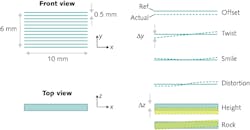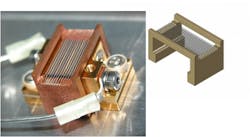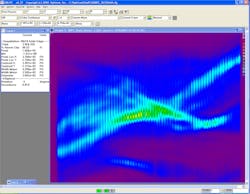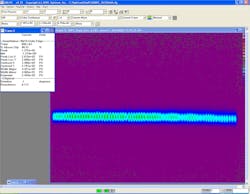LARRY GREEN and ETIENNE FRIEDRICH
Whenever size and energy consumption are critical to a laser-based system design, high-power diode lasers (HPDLs); are a natural choice. These lasers are generally more compact and efficient than other lasers, although they do have some key shortcomings.
An HPDL beam consists of beams from multiple individual semiconductor emitters that are assembled together in bars or stacks of bars. The parts assembly inevitably leaves room for deviation from a perfect, shared alignment and focus—and collimating optics only add to the problem. As a result, HPDLs suffer from small pointing errors, defocusing, and aberration impairments. These shortcomings can compromise efficiency and threaten to negate the benefits of HPDLs, especially because these devices have another limitation—poor beam brightness.
Especially for aeronautical and defense applications, then, it is critical to improve HPDL beam brightness by beam shaping. The European Space Agency is making just such an effort.
Goals and criteria
The ESA Living Planet Program is designed to find out more about our changing Earth. The Earth Explorer missions are the research missions of the Living Planet Program using satellites with new measurement techniques. Among these are light detection and ranging (LIDAR)-based instruments for monitoring wind, aerosols, or trace gas pollutants. One challenge for any space-based LIDAR is the need for an efficient and robust laser source. Several developments—such as the lightweight, high-brightness, thin-slab laser—are moving toward achieving this goal.
Related to this, the EarthCARE (Earth Clouds, Aerosols and Radiation Explorer) mission is a joint European-Japanese mission that addresses the need for a better understanding of the interactions between cloud, radiative, and aerosol processes and the role they play in climate regulation. The space agency gave the Centro Elettrotecnico Sperimentale Italiano (CESI, Milan, Italy) the task of developing an advanced LIDAR laser.
"We had to produce a predevelopment model for the Atmospheric LIDAR (ATLID) laser transmitter to operate," says Enzo Nava, Head of the Electro-optics Section at CESI. "In this case, we were developing an end-pumped Nd:YAG MOPA laser system with frequency tripling to produce 355 nm. The laser had to operate in Q-switched mode, with a narrow bandwidth and tight frequency control. We selected laser diodes to pump the small rod design that [incorporated] high-power quasi CW diode stacks with 1.2 kW peak power at 808 nm."
The team added Doric Lenses (Quebec, Canada) and PowerPhotonic (Edinburgh, Scotland) to the team. "We needed to identify industrial partners who could help with the required beam improvements," says Nava. "Since we already had experience with Doric Lenses, we turned to them to develop the collimation optics and to PowerPhotonic for the reshaping of the high-power laser diodes."
No trivial challenges
The design called for pump diodes with a beam profile of only 6 x 0.5 mm, and it was essential that the source be lightweight, compact, and reliable. A detailed analysis of these requirements led to the selection of a 12-bar conduction-cooled QCW diode stack with corrective phaseplates from Quantel Laser Diodes (Marcoussis, France) that is capable of operation at 1.2 kW peak power. These devices are available in a 500 µm bar pitch, providing the entire pump source within an area of only 6 x 10 mm (see Fig. 1). The stacks are robust and well suited to space deployment, having already been used in military applications.
However, the divergence properties of these stacks made them unsuitable for this application unless it was possible to develop a collimation process to fit on the stacks—not a trivial challenge because in addition to the divergence angle variations of each diode bar, the design team had to contend with the small clearance between lenses (as small as tens of microns), as well as the distortions of the bars themselves.
Different approaches have been used to fast-axis collimate laser-diode bar stacks. This project had to measure the exact position of each laser-diode bar over the stack, and then replicate the geometry into a custom-made lens holder that was used to build a FAC microlens array matching the laser diode bar position. Doric Lenses created custom insert microcylindrical collimating lenses aligned to each diode bar with a tolerance of less than ±5 µm (see Fig. 2).Before selecting microlenses to populate the lens array, numerical simulations were performed and showed that the Doric GRIN cylindrical microlenses were the best option because they are more forgiving to defocus or transverse position errors than acylindrical microlenses (although acylindrical lenses show better collimation when they can be perfectly aligned, it is best to assume that there will be a ±5µm residual defocus or transverse source position error). The cylindrical microlenses showed smaller ray aberrations than acylindrical lenses, which is crucial for phaseplate correction. The cylindrical lenses are also rotation symmetric, which enables more accurate positioning of the optical axis into the V-groove, and reduces the possibility roll alignment error.
The thin-slab architecture of this application places particularly stringent demands on pump beam collimation. The beams from each bar must be almost perfectly parallel, and must each have beam divergence close to the diffraction limit. Achieving this with primary collimation alone would require lens position tolerances of less than ±0.5 µm, which is beyond the capabilities of conventional machining processes. Instead, PowerPhotonic beam correction phaseplates enabled reshaping of the primary collimated wavefront in order to achieve the required beam performance.
Beam profiling for success
Aligning the optics and characterizing the beam required use of a beam profiler and Doric and PowerPhotonic chose Ophir-Spiricon (Logan, UT) Laser Beam Analyzers.
"The design and fabrication of custom micro-optic wavefront correctors, aimed at improving the beam brightness of HPDLs, requires an accurate analysis of the beam," says Roy McBrice, managing director at PowerPhotonic. "State-of-the-art characterization instruments are needed for precise beam assessment, which is important for fabrication of the correct phaseplate and the brightness of the HPDL.""The accuracy and reliability of the Ophir-Spiricon system made it an ideal choice to enable both design of the correction phaseplate and alignment to the corrected diode stack in real time," stated McBride. "Live visualization of the entire beam combined with accurate real-time measurement of beam divergence was essential. Correct alignment required real-time measurement of beam divergence with accuracy and repeatability of better than 0.1 mrad. We were able to characterize individual bars in the stack and obtain an image for the complete stack" (see Fig. 3).
When the custom-designed correction phaseplate was added, the beam appeared 10 times brighter than it was after the primary collimation (see Fig. 4).In this application, enclosed power is the critical divergence factor. Primary collimation reduced the beam divergence for a 90% enclosed power beam by a factor of about 30, from 75° to 2.6°. Beam correction further reduced this by a factor of about 10, to 0.28°, effectively reducing the M2 value from between 15 and 17 to equivalent to all bars being collimated with M2 = 1.6 (almost the diffraction limit) and perfectly aligned. The result is an extremely compact, high-brightness line source.
The combination of high-output diode-laser bars with a collimation and correction process—and being able to view and make adjustments in real time—enabled the successful design, test, and deployment of this very high-brightness diode laser. Trying to accomplish this complex process without a real-time beam profiler would have added enormous cost and time to the project.
In the end, the ESA HPDL project developed a highly efficient laser source with the required brightness. The team demonstrated that HPDLs are still the laser source of choice for any application that has tight requirements for size, efficiency, and performance.
Larry Green is industrial product manager for Ophir-Spiricon, Logan, UT; www.ophir-spiricon.com, e-mail: [email protected]. Etienne Friedrich is sales executive with PowerPhotonic, Edinburgh, Scotland, www.powerphotonic.com.



